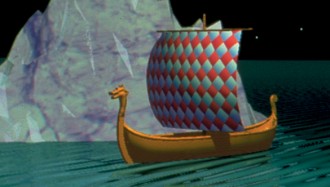
Norse America 1996
Distributed by Bullfrog Films, PO Box 149, Oley, PA 19547; 800-543-FROG (3764)
Produced by Timreck Productions Inc.
Directed by T. W. Timreck
VHS, color, 56 min.
High School - Adult
Anthropology, History
Date Entered: 11/09/2018
Reviewed by Rebecca Graves, J. Otto Lottes Health Sciences Library, University of Missouri-Columbia"Before Columbus, northern Europe had a long tradition of mythic lands to the west." Is it possible that legends and science can meet? This is Timreck's quest in Norse America. Pulling from Norse and Celtic legends and sagas as well as the science of archeology, he persuasively argues that the long tradition of lands to the west was not based upon legend but upon actual travel.
1000 years ago, the Norse were rulers of the northern world. Their sagas and legends were passed down orally and eventually written down in manuscripts by monks. They had settled from northern France to Scotland and Ireland. From the Scottish and Irish coasts they ventured out to Iceland and Greenland. While scholars agree on the above, debate arises over whether the Norse ventured farther west to the Americas. Timreck interviews a cadre of historians and archaeologist who have been searching for and studying archaeological sites for clues of Norse explorations to the new world. Some of these scholars have culled from the sagas' descriptions of unknown lands clues as to where the Norse may have sailed and settled. Such use of the sagas has helped in the discovery of sites such as L'Anse aux Meadows, a 1000 year old European settlement located on the coast of Newfoundland, and considered to be a base camp for further migration.
Timreck also explores the contact between the Norse and other cultures. It is possible that the Norse lived with the Celtic people, exchanged information and even combined forces when traveling west. The interactions between the Norse and Native American peoples is discussed as well. While often reported in the sagas as hostile confrontations, there is evidence here too of peaceful contact. Such contact belies the notion that the new and old worlds have gone through centuries of isolation with sporadic contact beginning after the voyages of Columbus.
Unlike Columbus, it appears that the Norse didn't push west for pure exploration or economic gain, but rather migrated west in search of habitable land. Another difference was the Norse view of the world. They saw it as round with a central sea ringed by land.
The film is well made if a bit slow at times and uses a combination of on-site footage, dramatic re-enactments, maps, computer generated graphics, and interviews. Portions of sagas are read and linked with archaeological evidence to support the theory that the Norse indeed traveled to the New World before and during the time of Columbus. Suitable for high school students and older in classes such as history, social studies, geography, and anthropology.